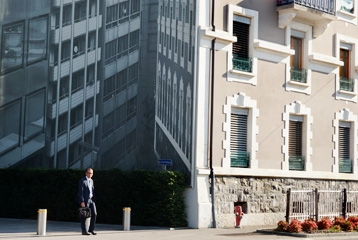Did you know? Unemployed people and youths built the Route des Jeunes, la Praille was covered with fields…
Unemployed people replacing mechanical diggers
To be able to construct the goods railway station of la Praille, the plain needed to be suitably prepared. The Drize and the Aire, which now come together underground near l’Etoile and flow beneath the Route des Jeunes before tumbling into the Arve, were channelled and forced underground. Work began in 1935 in the middle of the economic crisis. The decision was therefore taken to use the opportunity to provide work for a large number of unemployed people. To use as much physical labour as possible, mechanical diggers were completely abandoned in favour of manual labour, with the operation financed by means of an extraordinary loan.
Youth at work
The Drize was covered in 1935. A road was made alongside the newly-created canal. In 1942, 800 young volunteers laid 450 m of road in 139 days. The name “Route des Jeunes” acknowledges their commitment. To this day, the road demarcates the district of Acacias.
Memories of a market gardening past
During its history, the left bank of the Arve was long used as a garden to feed the inhabitants of Geneva. Some names recall this agricultural usage. La Praille, for example, comes from “pratalia”, meaning “group of meadows” in old French. The farmers were referred to plantaporrêts, a deformation of the expression “planteurs de poireaux”, or leek planters. A street even bears their name in la Jonction.
Wool industry at Queue d’Arve
The wool industry primarily developed in Geneva from 1550 with the arrival of Huguenot refugees from France who had the necessary know-how and capital. In 1797, in the region of Queue d’Arve, Charles Pictet de Rochemont purchased a dozen merino sheep from Louis XVI’s experimental farm in Rambouillet. The farm prospered and wool manufactured in Geneva was sold throughout Europe. Competition from English wool nevertheless put an end to this industry.
National Exhibition in les Vernets
The National Exhibition of 1896 was held in Geneva on both sides of the River Arve. On the right bank, around the Plainpalais plain, the pavilions showcased Swiss modernity. In les Vernets on the left bank, the focus was on “traditional Switzerland, with exhibitions on agriculture and the “Swiss village”.
Birth of the Beau Lac de Bâle in la Bâtie
The first edition of the festival de la Bâtie in 1977, which was held in the forest of the same name, witnessed the creation of an emblematic group comprising several generations: the Beau Lac de Bâle. This rock group, characterised by its sense of humour; brings together a vast audience around often parodic themes typical of Switzerland or Geneva, such as the trams 12 and 17, civil defence or Cénovis.
Oyster mushrooms under the cliffs
In the past, the caves in the cliffs of la Bâtie were used to store beer. Today, they are home to Geneva’s last active mushroom farm which produces oyster and shii-take mushrooms in cellars under the Rampe Quidort.
Sources:
- André Klopmann, Mon Dictionnaire de Genève, Geneva: Editions Slatkine, 2011
- Sites and monuments department of the state of Geneva, Secteur Praille-Acacias-Vernets: étude historique et patrimoniale, Geneva, 2006.
- City of Geneva, under the dir. of Rafael Matos-Wasem, Genève à pied. 10 parcours à thèmes, Geneva : Editions Slatkine, 2008
Article modifié le 25.09.2020 à 17:05

